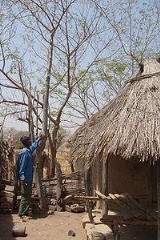
Tambacounda
Overview
Senegal
Senegal , officially the Republic of Senegal , is a country in western Africa. It owes its name to the Sénégal River that borders it to the east and north...
, 250 miles (402.3 km) southeast of Dakar
Dakar
Dakar is the capital city and largest city of Senegal. It is located on the Cap-Vert Peninsula on the Atlantic coast and is the westernmost city on the African mainland...
, and is the Regional capital of the province
Tambacounda Region
Tambacounda, formerly known as Sénégal Orientale, is a region of Senegal. It used to be part of the Mali Empire before the borders were created to separate Mali from Senegal. Tambacounda is physically the largest of Senegal's 11 regions, but is sparsely populated and its economy lags behind the...
of the same name. Its estimated population in 2007 was 78,800.
Tambacounda is situated on the sparsely populated sahélien
Sahel
The Sahel is the ecoclimatic and biogeographic zone of transition between the Sahara desert in the North and the Sudanian Savannas in the south.It stretches across the North African continent between the Atlantic Ocean and the Red Sea....
plains of eastern Senegal. Like most of West Africa, the area has two seasons, the rainy season from June to October, characterized by heat, humidity and storms, and the dry season from November to May.
Nearby towns include Madina Maboule, Koukari, Yoro Sankoule, Sambadian, Djidje Kounda and Kanderi Niana.
Between the censuses of 1988 and 2002, Tambacounda grew from 41,885 to 67,543 inhabitants.
In 2007, according to official estimates, the population reached 78,800 persons.
Settled first by Mandike
Mandinka people
The Mandinka, Malinke are one of the largest ethnic groups in West Africa with an estimated population of eleven million ....
peoples on the outskirts of the Mali Empire
Mali Empire
The Mali Empire or Mandingo Empire or Manden Kurufa was a West African empire of the Mandinka from c. 1230 to c. 1600. The empire was founded by Sundiata Keita and became renowned for the wealth of its rulers, especially Mansa Musa I...
, on the regular transhumance
Transhumance
Transhumance is the seasonal movement of people with their livestock between fixed summer and winter pastures. In montane regions it implies movement between higher pastures in summer and to lower valleys in winter. Herders have a permanent home, typically in valleys. Only the herds travel, with...
routes of Fula
Fula people
Fula people or Fulani or Fulbe are an ethnic group spread over many countries, predominantly in West Africa, but found also in Central Africa and Sudanese North Africa...
cattle herders, and settled again by Wolof
Wolof people
The Wolof are an ethnic group found in Senegal, The Gambia, and Mauritania.In Senegal, the Wolof form an ethnic plurality with about 43.3% of the population are Wolofs...
farmers in the early 20th century, Tambacounda has a mix of most of the ethnic groups in Senegal
Languages of Senegal
Senegal is a multilingual country - Ethnologue lists 36 languagesFrench, which was inherited from the colonial era, is the official language of Senegal. It is used by the administration and understood by about 15% - 20% of all males and about 1%-2% of all women...
.
The Tambacounda region is famous for its rich djembe
Djembe
A djembe also known as jembe, jenbe, djbobimbe, jymbe, yembe, or jimbay, or sanbanyi in Susu; is a skin-covered drum meant played with bare hands....
and dance culture and heritage.

